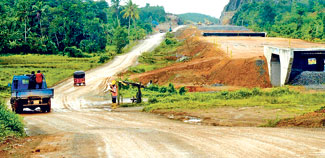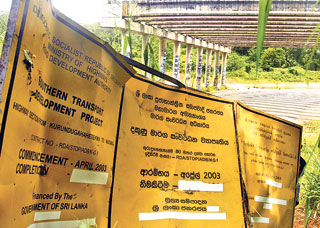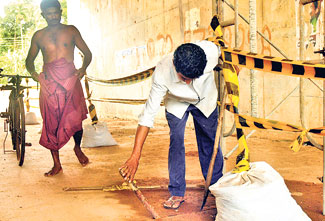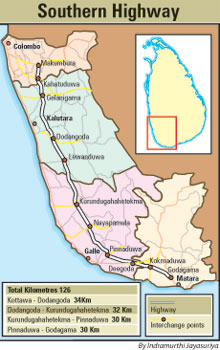One of Sri Lanka’s showpiece development projects – the 126 kilometre long Colombo Matara Southern Highway – costing over Rs. 70 billion would allow Sri Lankans to travel between the two towns in less than two hours. That is half the present travel time along the age-old narrow coastal road.
Though it would only cost what would seem a reasonable toll fee of three rupees for every kilometre per vehicle, an investigation by the Sunday Times INSIGHT team revealed that the ambitious project might remain only a dream at least for some time. The project is lagging well behind expectations due to a multitude of reasons whilst costs keep escalating.
Added to this is a veil of official secrecy; hiring and firing of sub-contractors, technical defects of hitherto untested bridges; and accusations between the authorities and the contractors that is likely to see the already massive cost shoot up by an estimated 10 billion; one-seventh the present cost.
Just last week, after the INSIGHT team sent a set of questions to the new Secretary, Ministry of Highways Admiral (Ret.) Wasantha Karannagoda, he not only assembled a group of journalists (The Sunday Times included) on a guided-tour of the highway, but also sent our questions, re-drafted with his answers to a daily newspaper.
The INSIGHT team found that some of the bridges coming up as the highway takes shape have collapsed even before use. In one instance a civilian was killed prompting the government to appoint a committee of inquiry from the Moratuwa University. Whilst their findings remain mysteriously unknown, defects have been detected in other new bridges. Villagers living along the highway have catalogued a multitude of woes including shoddy work by contractors and other irregularities.
One of the technical officers at the Baddegama site told us that sub-contractors had been dismissed for stealing material that had to go into the construction of both, the highway and the all-important bridges. Asked if the material was replaced or if the construction proceeded without the material, he shrugged his shoulders and didn’t give a straight answer.
 |
| A view of ongoing construction between Dodangoda in the Kalutara district and Kurudugahahethekma in the Galle district |
Transparency is non-existent in the entire project. At one place we found the notice boards -- with information giving the date of commencement of the project, the due date for completion, the costs etc., which is standard stuff for any foreign aided project -- has been removed, demolished or covered by stickers to hide the dates.
Meanwhile some of the concrete bridges in this section of the highway are of questionable quality. Residents in the area not far from the bridge that collapsed held a protest about two months ago, claiming that the concrete on the inside of the bridge is falling off. After a visit to the location in Poddala Warawala Walaw Watta we found out this to be true.
U. Jayaweera a mushroom cultivator who lives in the area is of the opinion that the bridge was not built according to proper methods and standards. He also pointed out that when a three to four metre rod is passed through the gap of the two concrete slabs in the under pass, the rod comes out covered in mud.
“The bridge was put across a paddy land without first filling up the land properly. This bridge has sunk in 3 ½ metres and we can’t go through it for the fear that parts of concrete would fall on us.
The fact that a part of concrete fell with no vehicle even crossing the bridge shows the quality of the work. During rainy days it gets muddy and the underpass goes under water. There are cracks that have appeared on the surface of the bridge. The culverts that have been built are not enough for the water to pass through so the area goes under water and it costs lakhs of rupees to pump it out every time it rains. There are so many problems in these bridges, one bridge not far from here collapsed and killed one, the one next to this one which is another metal arch is excessively corroded,” he said.
However, the RDA claims that the residents are agitated over nothing and that the concrete part that fell off was an extra piece which had seeped through the shuttering. We ran into a wall ourselves when it came to trying to elicit any information from the RDA at project level. The entire project seemed to be shrouded in secrecy. We first asked Ms. T.D. Wijewardene, the project engineer of the phase from Pinnaduwa to Godagama (Galle-Matara section) about the lack of activity in the area.
 |
| Fallen on the wayside: The board meant to give details of the project |
She said she would talk to us, but when we arrived at her office, she had left. From her office we telephoned Carl Fernando, Project Director stationed in Galle. He agreed to talk only if his Overall Project Director in Colombo, S. Meihandan would approve him doing so. When we called Mr. Meihandan, approval was given for us to talk to Mr. Fernando, but when we spoke to Mr. Fernando saying Mr. Meihandan had granted approval for him to speak to us, Mr. Fernando told us that Mr. Meihandan had told him not to speak to us.
Adm. (retd) Karannagoda said this would be Sri Lanka's first access-controlled toll expressway. It will connect Kottawa in Greater Colombo to Godagama in Matara. En route, at Pinnaduwa an interchange will connect it to Galle. He explained that the expressway would be only through 11 interchanges -- Makumbura, Dodangoda, Nayapamulla, Kokmaduwa, Kurudugahahethekma and Deegoda.
For financing purposes, he told the Sunday Times that the project has been divided into four sections. They are: From Kottawa to Dodangoda by JICA package (Japan International Cooperation Agency), Dodangoda to Kurudugahahethekma by JICA package 2, from Kurudugahahethekma to Pinnaduwa by the ADB (Asian Development Bank) and from Pinnaduwa to Godagama by China Exim Bank. He said there were 153 underpasses and 27 overpasses and nine major bridges.
“It was originally to be a two-lane project in 2003. However in 2007 we decided to make it a four lane project,” Sirisena Amarasekara, Chairman of Road Development Authority (RDA) told the Sunday Times. He said the Government was only now negotiating with China for the stretch from Akmeemana to Matara. Work will begin only after December and will take over two years to complete in this sector alone,” he said.
He said it was difficult to quantify the percentage of work completed. It is at different levels in different sectors.
Majority of the work in the Colombo end of the express way which is in Kottawa is yet to be completed. The first part of the road starting from the Colombo end falling through Kahathuduwa and Bandaragama area leading up to Dodangoda is far from being completed, most of the area still remains a mere wall of soil which has been piled up by the contractors. Our attempts to go through the road was dampened as the road was extremely muddy and slippery due to the rain and also we were told by some of the labourers who were at one of the construction sites of the highway in Kahathuduwa area that some of the underpasses went under water during heavy rain and not to risk it. According to Admiral (retd) Karannagoda only 52 percent of work of the highway from Kottawa to Dodangoda has been completed so far and has failed to meet the original completion date of September 2009. The new completion date has been set for March 2011.From Dodangoda to Kurudugahahethekma work is rapidly progressing. However the original date of completion of March 2010 as it is displayed in many of the hoardings at the site has been revised to December 2010.
The next part Kurudugahahethekma to Pinnaduwa where majority of the work has been completed is where ironically majority of problems have also cropped up. There are many questions raised about the introduction of metal arch bridges commonly seen in this section of the highway used for underpasses and waterways and technical problems have come up in some of the concrete bridges as well.
In some of the underpasses we could see water seeping through the metal frame where it has been joined by bolts. People in the areas are doubtful if this could be over looked as the acidity level of the water and soil in the area is high. Further as people pass through these underpasses they are either compelled to carry an umbrella when walking through long after rain has ceased or get wet from the water that drips through the bolts as it takes over a day for the soil on the metal arch which absorbs water to dry out after a heavy rain.
Mr. Amarasekara admitted there was a flaw in the bridges though the designs had been approved by the RDA in 2002 and 2003. He blamed the contractor for the bridge that collapsed killing one person.
“The problem is with the metal arches. We have not used this in Sri Lanka before and resorted to only the use of concrete. We have now asked the University of Moratuwa to conduct research and investigate the reasons,” he added.
Are the contractors using a cheaper method thus ignoring approved standards set by the RDA, we asked Mr. Amarasekara. His reply “They don’t tell us anything straight. They admit they have not tested the soil conditions in these areas to see the compatibility. We have a doubt whether the metal arches can be used, where the acidity level in the soil is concerned. Whilst awaiting the report of the University, there is a general consensus to remove the metal arches where it has been installed in water ways. We have decided to remove all of them.”
Asked about public complaints that the RDA had not properly supervised the work to ensure standards were maintained, Mr. Amarasekara said that the task has been given to a consultant.
However, he admitted that the faults in the bridges were due to lack of supervision on the part of RDA. “In the case of the bridge that collapsed, the fault is completely in the hands of the Engineer. The repair work was carried out for over a month. And if he had supervised properly, he had the authority to stop it at any time.”
The Sunday Times found that besides the collapsed bridge that killed a civilian in Poddala area questions have been raised about bridges at Atkandura and Gin Gaga. Further Mr. Amarasekara said that seven bridges that have been put across water ways will be removed as it was later realised that the bridge was likely to corrode. A sub contracting company called Access, which is a client approved sub contractor according to officials in the RDA has been providing what is feared to be sub standard metal bridges.
Referring to the bridge that collapsed causing the death of one, an Engineer spoke to us on grounds of anonymity. The local partner working as a sub contractor of the South Korean company has erred. “There had been an unbalanced settlement in the foundation. They were told to correct it. They did not follow proper guidelines when doing this. The metal arch collapsed due to this. The contractor did not even inform the RDA about the repair work nor say whether proper procedures were followed.” The unbalanced settlement he said may be a fault of the foundation. He also said that they are currently investigating where they believe that there may be a problem with the foundation in some of the bridges that have been put up.
When asked about the life time of the metal arches Mr. Amarasekara said contrary to the highway which has been designed for a life time of 100 years it was only 60 years not 100 years as in the case of other bridges that have been built in the country. “The problem we have is what type of maintenance would be carried out. A normal metal bridge has to be galvanized yearly. If it is the same in this case then it will cost us a lot in terms of maintenance,” Mr. Amarasekara said.
Buck-passing appeared to be the name of the game in this multi-billion rupee project. The main contractors Kumagi Gumi flatly refused to talk to the INSIGHT team. Access, the sub-contractors responsible for the metal arch bridge were reluctant at first but later were economical with the information we wanted.
When asked why no proper soil testing was done to judge whether the metal arch bridges were suitable for the soil conditions and acidity levels of the soil in that area and why this was not done before deciding on using these metal underpasses on the highway, Access' Director of Business Development, Darshana Munasinghe simply said that soil-testing was not within the scope of their sub-contract.
When asked the crucial question by us; "Have you taken steps to conduct this soil test now?", Mr. Munasinghe said again, "That does not come within our scope of work".
Again, asked if metal arch bridges used in waterways are now being removed, and if so, why they were used in the first place, Mr. Munasinghe responded with the following answer; ""We are not responsible for selecting the locations to install metal arch bridges".
Then asked about the questionable lifespan of these metal arch bridges, Mr. Munasinghe said, "We understand that the use of metal underpasses was specified in the tender Bidding Document. The relevant responsible persons would have considered the required lifespan when selecting them. Metal bridges have been used in highway construction worldwide and with proper maintenance it can last well over 100 years".
Former JVP Southern Provincial Councillor Ratna Gamage told the Sunday times that at the meeting with Highways Minister T. B. Ekanayake it was declared by the minister that 40 percent of the metal arches would be removed. This was widely reported in the media but strangely this has not been recorded in the minutes of the meeting.
The quality assurance the government is getting from the contractors ‘is still being pursued by the Highways Ministry and have to be concluded in the near future’ Admiral (retd.) Karannagoda said.
The new bridge across Gin Ganga has taken seven years to construct. A technical officer there told us it may take seven years more. The reasons? The foundation has cracked. To ascertain the reasons they have to break up the concrete beams. This meant having to pump water from the foundation area to place metal plates to block water from covering the foundation. This is costing Rs. 700,000 a day. RDA chairman Mr. Amarasekara said they have still not been able to identify what has gone wrong. There are doubts whether it was the cement or the water but no one knows for sure,” he said.
Who will bear the ultimate cost of the demolitions, removals, replacements and repair work which is happening even before the road is open to the public? The Highways secretary and the RDA chairman seem to have two different views. Admiral (retd.) Karannagoda said since it is a design and build contract, the contractor has to bear all costs. But Mr. Amarasekara said it will have to go to the arbitration tribunals before it is decided who is to bear the cost.
 |
| The stick that was thrust into the ground on the bridge came out covered in mud. |
“Nobody will agree to pay at once. We will have to see. Whether it is the consultant or the contractor who will have to pay will be deicided in an arbitration court trial,” he said.
However RDA chairman said that Kumagai Gumi, one of the contractor companies that is involved in the highway project has already put in a claim for Rs. 3000 million for delays caused due to various set backs such as protests by residents.
The decision whether to pay or not will depend on the arbitration court again said Mr. Amarasekara.
The section of the road from Akmeemana to Matara remains largely abandoned as the negotiations for funding for the construction is still on with the Chinese Government which will be given as a loan to the Sri Lankan government.
This section is now being utilised by residents as a platform to dry their paddy and most of the bridges which are half done remain abandoned while material such as iron rods and other machines have gone missing. The RDA said that they are considering whether to open up the road up to Akmeemana in 2011 provided it is complete by that time and connect it with the rest of the road up to Matara once it is completed. |




